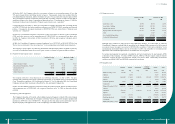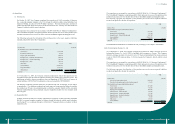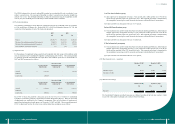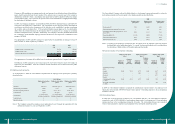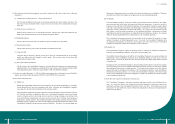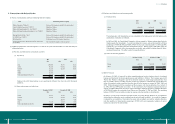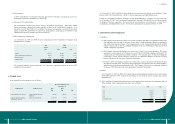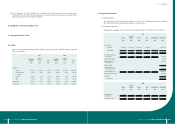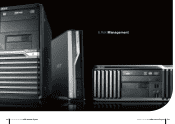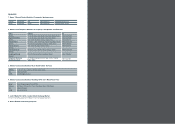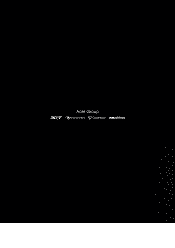Acer 2008 Annual Report Download - page 56
Download and view the complete annual report
Please find page 56 of the 2008 Acer annual report below. You can navigate through the pages in the report by either clicking on the pages listed below, or by using the keyword search tool below to find specific information within the annual report.
Acer Incorporated 2008 Annual Report108
Financial Standing
Acer Incorporated 2008 Annual Report 109
(b) The following methods and assumptions were used to estimate the fair value of each class of nancial
instruments:
(i) Available-for-sale nancial assets – current and noncurrent
The fair value of publicly traded stocks is the closing quotation price at the balance sheet date. The
fair value of open-end mutual funds is based on the net asset value of the mutual funds at balance
sheet date.
(ii) Financial assets carried at cost
Financial assets carried at cost were privately held stock. The fair value of privately held stock was
unable to be determined because it was not traded in the public market.
(iii) Refundable deposits
The fair values are the book values as the date of expiry was unable to be determined.
(iv) Noncurrent receivables
The fair values are their present value discounted at the market interest rate.
(v) Long-term debt
Long-term debt is obtained at floating interest rates which are calculated based on the prevailing
market rate adjusted by the Company’s credit spread. The carrying value of long-term debt
approximates the market value.
(vi) Derivative nancial instruments
The fair values of the Consolidated Companies’ derivative nancial instruments are estimated using a
valuation method. The assumptions used should be the same as those used by nancial market traders
when quoting their prices, which are readily available to the Consolidated Companies.
(c) For the years ended December 31, 2007 and 2008, remeasurement loss on nancial assets and liabilities
using an assessment method amounted to NT$121,332 and NT$989,905, respectively.
(d) Disclosure of nancial risks
(i) Market risk
Mutual funds and publicly traded stocks were recorded by the Consolidated Companies as “available-
for-sale nancial assets” and were evaluated by fair value. Therefore, the Consolidated Companies
were exposed to the risk of price uctuation in the securities market.
The Consolidated Companies engaged in purchase and sale transactions with the functional currency
of US dollars and Euros, respectively. Hence, the Consolidated Companies entered into foreign
currency forward contracts and foreign currency options to hedge exchange risk resulting from
assets and liabilities denominated in foreign currency and cash flows resulting from anticipated
transactions in foreign currency. The lengths and amounts of the foreign exchange forward contracts
and foreign currency options were in line with the settlement date and anticipated cash outows of the
Consolidated Companies’ foreign currency assets and liabilities. The gain or loss from exchange rate
uctuation of hedging derivatives was offset by that from the hedged assets or liabilities. Therefore,
the market risk related to the changes in exchange rates was not considered signicant.
(ii) Credit risk
The Consolidated Companies’ credit risk is mainly from potential breach of contract by the counter-
party associated with cash, equity investment, and derivative transactions. In order to control its
exposure to the credit risk of each nancial institution, the Consolidated Companies usually deposit
cash with various financial institutions and hold equity investments in the form of mutual funds
and stocks issued by companies with high credit quality. As a result, the concentration of credit
risks related to cash and equity investments is not considered significant. Furthermore, the banks
undertaking the derivative transactions are reputable financial institutions; therefore, the exposure
related to the potential default by those counter-parties is not considered signicant.
The Consolidated Companies primarily sell and market the Acer-branded IT products to a large
number of customers in different geographic areas. As a result, the Consolidated Companies have
no significant concentrations of credit risk, and in order to lower the credit risk, the Consolidated
Companies continuously evaluate the credit quality of their customers.
(iii) Liquidity risk
The Consolidated Companies’ capital and operating funds are sufcient to reimburse all obligations.
Therefore, the Consolidated Companies do not expect to have liquidity risk.
The available-for-sale nancial assets held by the Consolidated Companies are equity securities and
mutual funds, which are publicly traded and can be liquidated quickly at a price close to the fair
market value. In contrast, the nancial assets carried at cost are not publicly traded and are exposed
to liquidity risk.
The purpose of the Consolidated Companies’ derivative nancial instruments is to hedge the exchange
rate risk resulting from assets and liabilities denominated in foreign currency and cash ows resulting
from anticipated transactions in foreign currency. The lengths of the contracts are in line with the
payment date and the anticipated cash outows of the Consolidated Companies’ assets and liabilities
denominated in foreign currency. As a result, the Consolidated Companies settle their foreign
currency assets and liabilities with contract obligations or rights at the maturity date and do not expect
to have signicant liquidity risk.
(iv) Cash ow risk related to the uctuation of interest rates
The Consolidated Companies’ short-term borrowings and long-term debt carried floating interest
rates. As a result, the effective rate changes along with the uctuation of the market interest rates
and thereby influences the Consolidated Companies’ future cash flow. If the market interest rate
increases by 1%, cash outows in respect of these interest payments would increase by approximately
NT$134,718 per annum.



